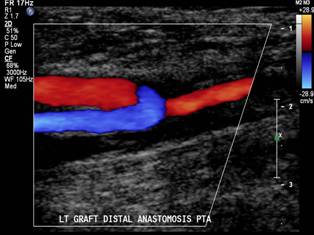Bypass graft evaluation
 An arterial bypass graft using a person's own vein for the graft is the most durable means to treat severe, peripheral, artery disease when the blockage is below the level of the groin. Vein bypass grafts offer many advantages. They can be used for extensive arterial blockages, which are common with diabetes, as well as blockages involving smaller arteries below the knee. They are resistant to infection. Also, vein grafts may work where grafts using prosthetic material have failed.
An arterial bypass graft using a person's own vein for the graft is the most durable means to treat severe, peripheral, artery disease when the blockage is below the level of the groin. Vein bypass grafts offer many advantages. They can be used for extensive arterial blockages, which are common with diabetes, as well as blockages involving smaller arteries below the knee. They are resistant to infection. Also, vein grafts may work where grafts using prosthetic material have failed.
For these grafts to work, however, there must be sufficient flow through the graft. Ultrasound evaluation or X-ray imaging is done at the time of the operation to ensure there is adequate flow, but in some cases narrowings can subsequently develop within the graft or arteries. When this occurs in the first two years after the operation, it is most commonly due to intimal hyperplasia, a process that is somewhat like scar formation within the graft. If this is detected before the graft becomes completely occluded, a procedure may be performed to repair or bypass the narrowed segment. As these changes within the vein graft may not cause any observable symptoms until it is too late, Vascular Laboratory testing is regularly used to detect a problem at a fixable stage.
No special preparation is required for a graft surveillance examination. In addition to a complete duplex scan of the graft and the inflow and outflow arteries, ankle and arm blood pressures will be measured using inflatable cuffs and an ultrasound Doppler flow detector. A complete study usually takes 30 to 90 minutes.
Vein bypass grafts are evaluated at three-month intervals for the first year after surgery. Surveillance studies are done every six months in the second year, then annually thereafter. Shorter interval surveillance may be recommended if an irregularity is found.
Graft surveillance for UC Davis Medical Center patients also includes follow-up visits to the Vascular Surgery Clinic or telephone follow-up with the Vascular Resource Nurse or other member of the Division of Vascular Surgery staff.
See also:
Diseases, conditions and their treatments: Peripheral artery disease (PAD)
Diseases, conditions and their treatments: Critical limb ischemia
Vascular Laboratory exams: Lower extremity physiologic testing
Vascular Laboratory exams: Peripheral arterial duplex scanning
Vascular Laboratory exams: Treadmill exercise testing
Vascular Laboratory exams: Vein mapping
